 Get premium membership
Get premium membership and access revision papers with marking schemes, video lessons and live classes.
Form 3 Chemistry Paper 1 End of Term 2 Examination 2022
Class: Form 3
Subject: Chemistry
Level: High School
Exam Category: Form 3 End Term 2 Exams
Document Type: Pdf
Views: 502
Downloads: 14
Exam Summary
1. In a neutralization reaction, Sodium carbonate solution was dissolved in water and the solution made to 250cm3. 25cm3 of this solution neutralized 20cm3 of 0.25M nitric acid. Calculate the mass of carbonate that was dissolved in water. (3mks)
2. When a piece of burning magnesium is lowered into a gas jar of sulphur (IV) oxide it continues to burn for some time. a) State and explain the observations made. (3mks) b) Write a chemical equation for the reaction which occurred. (1 mk)
3. Starting with distilled water and solid Lead (II) nitrate; describe how a sample of Lead (11) carbonate can be prepared. (3mks)
4(a) State Graham’s law of diffusion. (1 mk)
(b) A certain volume of gas Stakes 180 seconds to diffuse through a porous plug. Molar mass of S is 18. Equal volume of gas Q takes 240 seconds to diffuse through the same plug. Calculate the molar mass of Q. (2mks)
5. Calcium nitrate is a nitrogenous fertilizer. Calculate the percentage of nitrogen in the fertilizer (N=14.0, Ca=40.0, O=16.0) (2mks)
6. 3.22g of hydrated Sodium Sulphate, Na2SO4oX H2O were heated to a constant mass of 1.42g, determine the value of X in the formula. (Na = 23, S = 32, O = 16, H=1). (2 mks) 7. The diagram below shows the heating curve of a pure substance. Study it and answer the questions that follow.
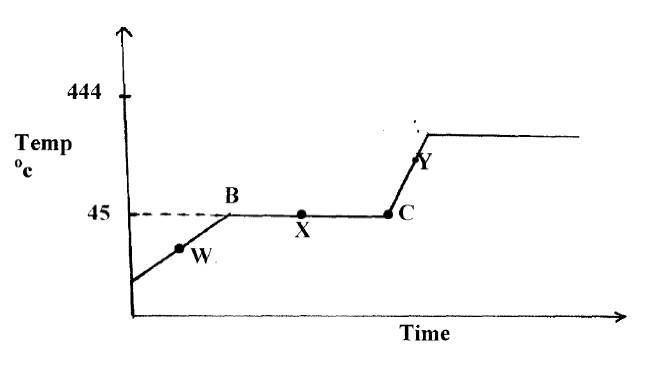
(a) What are the physical states of the substances at points W and Y. (2mks) W— Y—
(b) Explain why the temperature remains constant between points B and C. (2mks)
8. The set up below was used to prepare gas X. study it and answer the questions that follow;
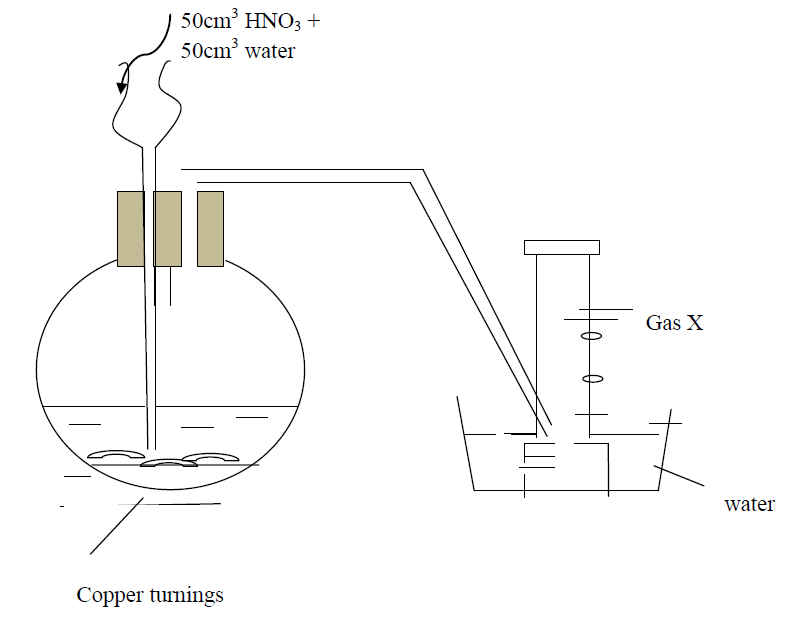
a) Name gas X (1mk)
b) Write an equation for production of gas X in the set up (1mk)
c) It’s hard to test whether gas X supports burning using a glowing splint. Explain. (1mk)
9. Differentiate between the terms atomic number and mass number (2mks)
10. The diagram below shows a set-up of apparatus used to separate immiscible liquids.
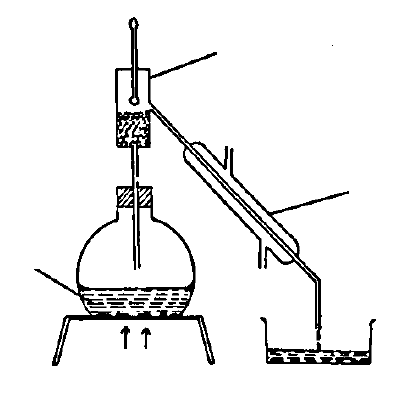
a) Name the parts labeled A and B. (1 mark)
A B
b) State the function of the part labelled A . (1 mark)
c) State the property of the mixture that makes it suitable to be separated by the method above. (1 mark)
11. In an experiment, concentrated sulphuric acid was put in a beaker and exposed to air for one week as shown below.
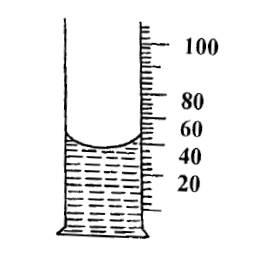
i. What observation was made after one week? Explain. (2marks)
ii. What property of sulphuric acid was being investigated in the experiment? (1 mark)
12. Identify the type of bond formed in (i) and (ii) (2 marks)
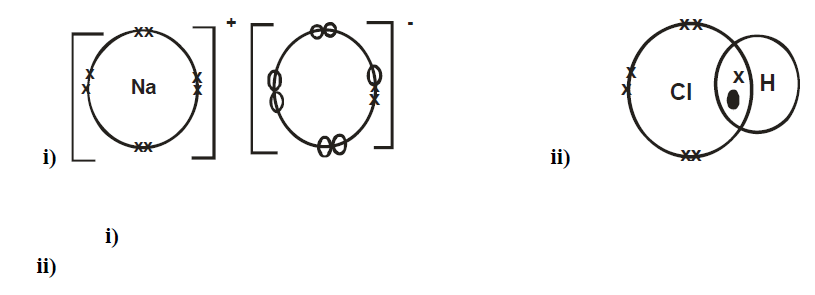
13. In an experiment to prepare nitrogen (I) oxide, ammonium nitrate was gently heated in a flask.
a) State and explain how the gas was collected. (1 mark)
b) A sample of the gas was tested with damp blue and red litmus papers. What observations were made? (1 mark)
14. The grid below is part of the periodic table. Use it to answer the questions that follow.
(The letters do not represent the actual symbols of the elements)

a) Indicate in the grid the position of an element represented by letter V, Whose atomic number is 14.
(1 mark)
b) Select a letter which represents a mono atomic gas. (1 mark)
c) Write an equation for the reaction between Q and T. (1 mark)
15. Below is a set-up of apparatus used to prepare hydrogen gas in the laboratory. Study it and answer the questions that follow.
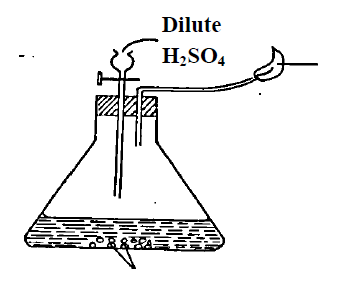
a) Write the chemical equation for the two reactions taking place in the above set up. (1 mark)
b) State the chemical test for hydrogen gas. (1 mark)
16. Below is a table of 1st ionization energies for elements A, B, C and D which are metals.

a) What is meant by 1st ionization energy? (1 mark)
b) With an explanation, arrange the elements in order of increasing reactivities .(1 mark)
17 a) What are alkali metals? (1 mark)
b) Explain why potassium atom is larger than sodium atom. (1 mark)
18. The simplified flow chart shows some of the steps in the manufacture of sodium carbonate by the Solvay process
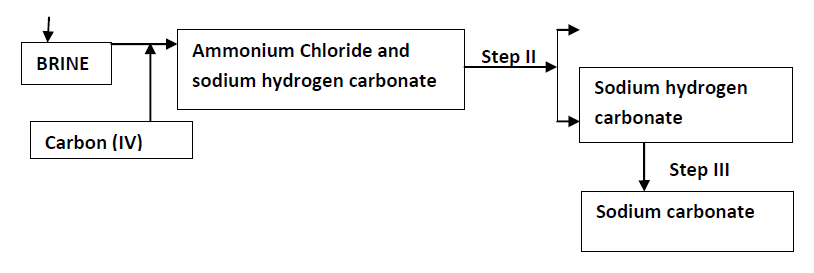
a) Identify substance G. (1mk)
b) Name the process – taking place in step II (1mk)
c) Write an equation for the reaction, which takes place in step III. (1mk)
19. Sodium and Magnesium belong to the same period on the periodic table and both are metal. Explain why magnesium is a better conductor of electricity than sodium. (2mks)
20. Atoms of element E exists as 146E and 126E
a) What name is given to the types of atoms (1mk)
b) Draw an illustration the atomic structure of E (1mk)
c) Write the formula of the oxide of E. (Atomic number of O = 8) (1mk)
21 a) What is allotropy? (1mk)
b) Name two elements that exhibit autotrophy. (2mks)
22. The set-up was used to prepare carbon (IV) oxide and investigate its properties.
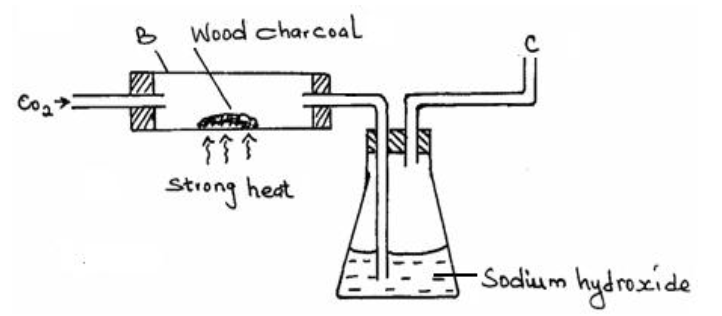
(a) Write an equation for the reaction in vessel B. (1 mark)
(b) What is the role of sodium hydroxide solution in the set-up? (1 mark)
What would be observed if a burning splint is introduced at jet C? (1 mark)
23. Write down the property of concentrated sulphuric (VI) acid shown in the following reactions.

24. Element X contains isotopes with mass number 16 and 18 respectively existing in the ratio 1:3 calculate the relative atomic mass of X. (2 marks)
25. Study the table below and use it to answer the questions that follow.

(i) In which of the solution will phenolphthalein indicator be colorless. (1 mark)
(ii) Which of the solutions could be used to relieve heartburn? Explain. (2 marks)
26. 1.26g of lead powder were dissolved in excess nitric (VI) acid to form lead nitrate solution. All the lead nitrate
solution was reacted with sodium sulphate solution.
(a) Write an ionic equation for the reaction between lead nitrate and sodium sulphate solutions.
(1 mark)
(b) Determine the mass of lead salt formed in(a) above (Pb = 207, S = 32, O = 16 (2 marks)
27. The figure below shows a burning splint that was put across the middle of a non-luminous flame.Explain the results.

28. The following chromatogram was obtained in an experiment to investigate the components present in certain dyes.
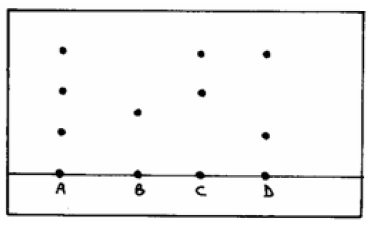
(a) Which two dyes when mixed would produce A? (1 mark)
Which dye is pure? (1 mark)
(b) Indicate on the diagram the solvent front. (1 mark)
(c)
29. Draw a dot (.)/cross (X) diagram to show bonding in Cl2O. (Cl = 17, O = 8). (2 mark)
b. In terms of structure and bonding explain why the component Cl2O has a very low melting and boiling point. (2 marks)
30. The figure below shows a set-up used in electrolysis of lead iodide.
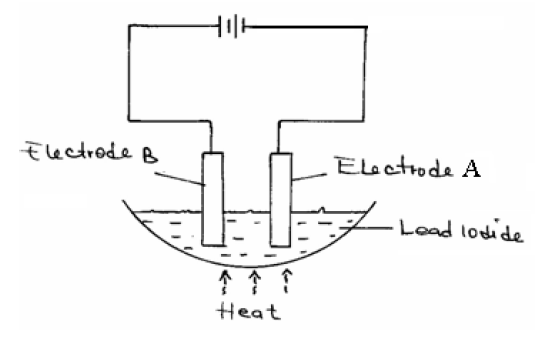
(a) Why is heating necessary? (1 mark)
(b) Write the equation of the reaction that occurs at the cathode. (2 mark)
(c) At which electrode does reduction occurs. (1 mark)
More Examination Papers